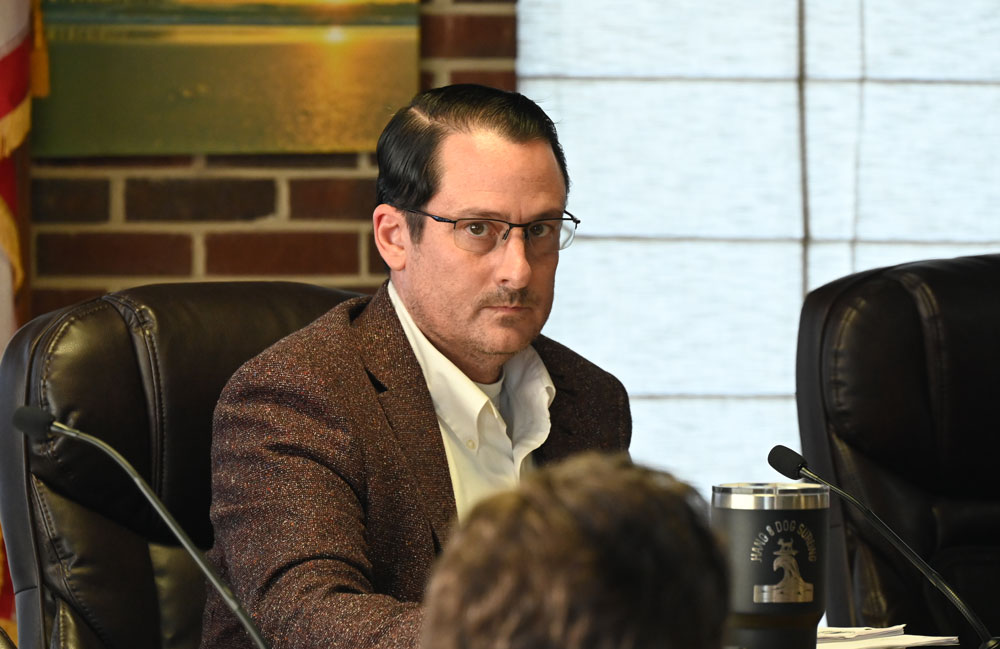
Flagler Beach Is ready to raise its property tax and dedicate the new revenue to beach protection in the city as a blunt message to the county: We’re doing our part. Now do yours.
The city is ready to increase its property tax rate from $5.45 per $1,000 in taxable value to almost $6, and pledge every penny of the expected $715,000 annual revenue to beach protection. A house with a taxable value of $300,000 with a $50,000 homestead exemption would end up paying $125 a year.
Flagler Beach commissioners, at Commissioner Eric Cooley’s suggestion, directed City Manager Dale Martin to develop a plan that would turn that pledge into reality by next year. Cooley proposed the plan at last night’s meeting of the commission, both to reassert the city’s commitment to beach protection within its borders and to send a message to the county: that the city is ready to do its part, but not to be held hostage to the County Commission’s confusing politics.
The move is not in defiance of the county so much as a challenge to it to get its management plan in order and to stop using Flagler Beach as a scapegoat to veil its own internal conflicts.
“The main thing is getting it on the table and saying: Are we willing to move forward with what we already agreed to formally and get that going?” Cooley said. The commission’s answer was a decisive yes. Commissioner Rick Belhumeur, who was not at the meeting, called the approach “brilliant” after listening to the segment.
The committment is not a change in policy: the Flagler Beach City Commission had jumped on board of the county’s comprehensive beach-protection plan last March, explicitly stating as a commission that it was ready to approve an increase in the sales tax, give away all its share of the sales tax revenue, or close to $300,000 a year, so the county could put it toward beach protection.
Flagler Beach was also prepared to approve a new special taxing district on its residents that would have imposed a $160 fee per property. The $160 fee was the county’s figure and the county’s idea. It would have generated $715,000 in Flagler Beach. That money would have been pledged to beach protection. The Flagler Beach City Commission approved that, too, in that March meeting when Cooley encapsulated the city’s commitment with two words: “all in.”
The county administration and some members of the County Commission were briefly jubilant. It looked like the county would finally have a comprehensive beach management plan.
Then it all went to pieces–not in Flagler Beach, but at the County Commission. Commissioners Kim Carney, Pam Richardson and Leann Pennington killed the beach-management plan, because they were opposed to a sales tax increase. The county has been hunting for a replacement plan since–and hounding Flagler Beach to “do its part.”
To Flagler Beach commissioners, the city was always ready to do its part. It’s the county that’s confused, confusing, and “politicizing” the issue, in Cooley’s view. For months, and at the urging of Carney, the county has been seeking a joint meeting with the city to work out a plan for a special taxing district there, either an MSBU or an MSTU.
Under an MSBU, or a Municipal Service Benefit Unit, the tax is a flat rate. A $200,000 house would be charged the same fee as a $4 million house. Under an MSTU, or a Municipal Service Taxing Unit, the levy is based on the property value. The higher the value, the higher the levy. The approach Cooley proposed Thursday is an MSTU–a taxing district that would proportionally tax properties.
On Oct. 17, County Administrator Heidi Petito, who’s survived whiplash from her commission’s zigzagging and contorted directions (when there’s been direction), sent a letter to Flagler Beach City Manager Dale Martin and the city commission. She again asked for a joint meeting. She laid out a tight timeline for establishing a special taxing district, with one deadline as soon as December.
Cooley took the initiative Thursday evening. He proposed that the city move ahead with a special taxing district on its own to show it is committed.
“What I would propose is we say yes, we’re in. We want to have ownership of what we already agreed we would do, and we are interested in helping out. We are playing ball, and we move forward with what we agreed on.” That, Cooley said, would stop the back and forth between the city and the county, with the county chasing after Flagler Beach and Flagler Beach not having a clear position. “Then at least county knows: Here’s where Flagler Beach stands. And if there’s any gap in funding, then they can look at alternate sources to bridge that gap. But it pulls us out, because we’ve now done our part, and we said, here’s what we’re in for, which was the original agreed amount. And we move forward with that.”
Cooley prefers the MSTU approach because he says it’s more equitable. The tax rate would be set at whatever would raise the needed $715,000. The county, Petito wrote in her letter, is seeking $1.4 million from the city, double what Flagler Beach is prepared to provide. But that $1.4 million includes money that would once have been generated by the new sales tax–which Flagler Beach was ready to hand over. Now that the county has killed the sales tax, Flagler Beach is not interested in making up that gap on its own. It only wants to stick to its original commitment. If there is a gap to bridge, it’s the county’s bridge to build, the city commission says.
“What I get concerned about is this is turning into a highly political issue, because there are other elected officials out there who want different numbers than what we already agreed to,” Cooley said. “Well, that’s all fine, dandy. They can want all they want. But we agree to a particular number.”
“I agree with that 100 percent,” Flagler Beach Commissioner Scott Spradley said, “because we would be making our commitment, and I would think that the county would have no issue with how we differentiate amongst ourselves, is how that number comes to be. That’s our business. It’s not their business if the number is the same. So I think in order to accomplish that, we would just need to do a little reverse computation and see what, mill rate [or property tax rate] it would take to result at that number, and then discuss it from there. But to me, I would think that the county would have no opinion on that.”
Spradley, too, considers the special taxing district based on property values more equitable than a flat fee.
“I’m on board with that, too,” Commissioner John Cunningham said.
“I would not think the county would even have a comment on how we get there. The main thing is that we’re there, and us getting there, that is the important thing,” Cooley said. The taxing district would apply to all properties in the city limits, universally. He rejected the notion that houses closer to the beach should pay a higher rate.
City Attorney Drew Smith said the city can craft its taxing district first by writing a letter to the county outlining its plan. The other approach is to request a special taxing district through the county, which would have to approve that district by resolution.
Martin, the city manager, had an even bolder approach: draft the special taxing district resolution now. Increase the tax rate by the required half-mill. Escrow the revenue. “Then when it comes time to pay the piper or pay the county, we can at least demonstrate that we have the money and we maintain the flexibility of that,” Martin said. “So you’re agreeing to an additional half a mill on everybody’s tax bill, but it’s strictly under our control. Because I know you expressed some concerns, like, Okay, this money goes to the county. It’s strictly under their control. What sort of lockbox and we put it into?” If the money is in the city’s hands, it’s dedicated to beach protection, lockbox fashion, pledged to the county.
Smith calls it “a way of sweetening the deal on the political angle,” even though it’s outside the statutory process of getting to a special taxing district. But Smith had no issue with Martin’s proposal. Eventually, the city and the county would have to have matching ordinances.
“This was all very straightforward with us. It was presented, we agreed to it, we support it,” Cooley said. The county has politicized it, he said, with its own internal dissension on what to do next, and how. “It’s not that I don’t trust County, I just don’t trust anybody.”
As for the disparity between the $715,000 Flagler Beach is ready to provide and the $1.4 million the county is looking for from the city, Spradley said: “We committed to the $700,000 when approached by the County originally, which is the commitment that was requested. That’s where we still stand,” Spradley said.
Belhumeur put it almost identically, though he was interviewed separately: “We didn’t take that off the table, the county did,” he said of the sales tax, which would have generated additional revenue. “We will be giving them exactly what they asked for and we agreed to.”
“This is all about being fair and equitable,” Spradley said. “While the stretch of beach within the city limits is obviously located within Flagler Beach, it is used by all. In fact, the town and the beach of Flagler Beach are highly and successfully marketed by the County and by Palm Coast as they increase their own growth. Having them contribute fairly and equitably to maintain this critical County asset is proper, since the overwhelming majority of beachgoers are from outside the Flagler Beach city limits.”
But with mention of Palm Coast, Spradley was veering toward the issue’s third rail.




























bix says
WE don’t go to the beach or any of the shop’s So why should we pay for it the county get nothing back from it and we support it though fire /police
Joe D says
Reply to bix:
OPPS….Flagler County gets “Nothing” back from beach replenishment investment???….CLEARLY you’ve FORGOTTEN about the $900,000,000 in revenue Flagler Beach generates…EACH YEAR for the County! Try generating THAT without the Beach as your PRIMARY local tourist attraction!
That’s okay, in addition to the extra tax I’ll be paying under this new proposal as the owner of a small 2 bedroom, 1.5 bath 1145 sq ft townhouse in Flagler Beach, for the privilege of supporting the 4 out of 5 beach users from Palm Coast ( documented from CELL TOWER DATA) with my extra fees…I HOPE the City of Flagler Beach initiates paid parking throughout most of the City Limits( especially with kiosks in the downtown and Beach areas), and makes it the equivalent price per hour as the Daytona and other nearby beach areas charge….and offers ( at basic production cost) a parking sticker for DOCUMENTED Flagler Beach Resident long term renters and owners ( with household limits or driver’s license proof of residency) for reduced cost ( not “Free” or the cars would be parked and NEVER MOVED by local residents) and time limited parking on street /beach and local lot parking.
I think SOMETHING in that order would then ONLY cost the non-Flagler Beach Residents who use the beach. SOUNDS FAIR DOESN’T IT!?!
PS: for “bix” and those of you living outside Flagler Beach—-we already pay our per capita county taxes for police/ fire / emergency services, and we ALREADY pay OVERTIME to the County Emergency services for additional police, event coverage by Ambulance services , most of the beach lifeguards protecting everyone ( including the 4 out of 5 beach users from Palm Coast)!
Sorry if this sounds SARCASTIC, but when I can’t park near my own home even during the week ( forget parking on the weekends or holiday) due to the out of area parking, the PETTINESS of some non-Flagler Beach residents just infuriates me on the issue of maintaining the beach.
Duncan says
Flagler County Deserves Better!
Thank you, Flagler Beach, for helping to expose just how misguided the actions of Kim Carney, Pam Richardson, and Leann Pennington have been on funding beach renourishment.
What should have been a straightforward plan to protect our coastline has been turned into an unnecessarily complex and frustrating mess — forcing little Flagler Beach to teach the county lessons in basic common sense and follow-through.
The sales tax was the most logical and responsible way to fund the majority of a long-term renourishment program. It made perfect sense. Instead, because of political posturing framed as “tax relief,” we’re now left with fewer, far less effective options to protect the county’s most valuable and irreplaceable asset — our beach.
Their actions have come at a real cost to every resident of Flagler County. Flagler stands as the only coastal county in Florida without an active beach renourishment program — a distinction no one should be proud of.
Our beaches drive our economy, tourism, and quality of life. They deserve leadership grounded in foresight and responsibility — not politics and ego.
Shark says
Just build a seawall and let nature take it’s course !!!
Mothersworry says
Sounds good! Does this mean that the city is in charge of the re-nourishment rather than the county? The county said a few times that they would take care of the beach south of the water tower to the county line. It has never happened!!
FlaglerLive says
@motherworyhy, the county and the city have signed a mutual agreement leaving actual beach management to the county. Funding is a separate challenge.
Fernando Melendez says
Here we go again, let’s see what’s up their sleeves now.
Jay Gardner says
Way to go Flagler Beach. Hope the county figures it out. The beach affects all properties in our county. If we don’t take care of the beach and we loose tourism we will see higher tax bills to make up for the loss. If not for the beach we would be Putnam County and our tax rate would be maxed out. Sales tax is paid for by all including tourist. Let’s get a plan in place.
Greg says
Just maybe someday, Flagler County will no the right thing and pass a half cent sales tax to protect the dunes. The county has zero leadership.
Tim says
Like him or not, Commissioner Cooley does not let grass grow under his feet. Flagler Beach seems to be in better hands than the County at the moment.
Laurel says
Flagler County is so f**ked up! No mention of the tourist bed tax, but lots of talk that residents should pay for the beach. Funny how that works.
The rent is going up. That’s okay with you folks, right? I’m so sick of the talk that tourists somehow help all of us, they do not.
We moved to this area to get away from the excessive growth and congestion we’ve experienced down south, but greed always catches up for the few who actually profit. Margaritaville has changed Flagler Beach, and not in a good way. It’s turning into a cookie cutter town. Nothing new to see here.
Hey Flagler Beach, why didn’t you sell the golf course at a realistic price, and use that money for the beach?
MM says
What exactly does “beach protection” mean? There is nothing that can be done about the ocean taking over Flagler Beach. A1A will not be around much longer. The town is doomed and climate change has spoken. Throwing more money into trying to build up sand dunes and such is ridiculous and throwing money away. It is not a big tourist attraction anyway, not like most o the East Coast towns are, it has nothing to offer, and is old, worn and outdated. Best they could hope for would be condo’s with water views, build back far enough to last for 100 years or so. Maybe some more big beautiful hotels and shops. It’s called facing reality.
Concerned Citizen says
If anyone is looking to blame anyone for the political mess in this county. Look no further than the mirror. Folks keep electing the same people. And expect different. The sad part is these folks get in there and never leave. Building personal empires. Time for change. And it begins with us at the polls. DO BETTER FLAGLER COUNTY
Jane Gentile-Youd says
The voters made their choices. Sales tax only way to go and get rid of all County Commissioners and Madame Petito.
Eric Cooley has more brains and common sense in his rear than any of them do in their dense non transparent heads.
Jim says
I’m a Flagler beach resident for over 30 years.If I have to pay I have to pay. Just install parking meters and let the visitors pay some of the expenses. All Flager beach property owns should be exempt from paying parking fees.
La verdad says
The ocean is rising, the island will be wiped from the earth. Money will not change that. Taxing people silly and pretending it will make a difference is insanity. Before then, insurance companies will stop writing policies and the state will run out of money for “Citizens.” No insurance means property values will be wiped out. Flagler Beach and every other coastal community will slowly wither and die. Smart leaders would plan for strategic retreat over the next twenty years.
Deborah Coffey says
Thank you, MM and Concerned Citizen. You are spot on. It’s almost laughable that a bunch of climate change deniers are trying so hard to stop an ocean by supporting Trump…the guy that just stopped ALL efforts at protecting Americans from its clear and present and deadly effects.
Citizen says
Compare Flagler to Putnam…Flagler has grown the past 10 and 20 years, not Putnam. Flagler is still growing and real estate in Flagler demands a higher cost than Putnam. Nearly every real estate listing in Flagler and new development mentions the beach and/or the proximity to the beach. The beach IS the economic driver of Flagler, period. So even if you dont use the beach, you enjoy a higher real estate premium and access to high quality businesses, because of the beach. Flagler is special because of 18 miles of beach access. Homes close to the beach are assessed at higher values and thus already pay more in taxes. The entire county has an interest in preserving the beach and thus the entire county should help restore the beach.
Jane Gentile Youd says
No beach to visit? No tourist tax for the county to ‘rob’ from
Eric Cooley has more brains in his read end than the 3 ladies on the county commission.
1/2 cent sales tax will only really hut a little when you buy a car…
Let’s save what beings our money in, the beach, and get rid of the idiots om the county commission who could care less about anything other than getting re-elected. go Eric go!
Palm Coast Citizen says
My concern is that both the Florida Legislature and the Governor are strongly signaling an intent to limit or eliminate local property-tax authority. If that happens—especially through a constitutional amendment that preempts local ad valorem taxation—it could directly affect Flagler County’s ability to fund services through an MSTU and could even create uncertainty for MSBUs.
While an MSBU isn’t technically a property tax, it’s still a non-ad valorem assessment that appears on the same bill, and it could easily become politically or administratively vulnerable if property-based revenues are restricted at the state level.
That’s why I felt the half-cent sales tax would have been the more forward-looking option. It would have provided a diversified, more resilient funding source in case the state continues to chip away at local governments’ ability to rely on property-based revenue.
Void after ninety days says
Why is the beach the only thing everyone wants to talk about?
Blaming our three female Commissioners is not the answer. They have other projects that need just as much attention.
Raise those taxes, it’s Cooley Democrats that wants to tax everyone to death.
Why rebuild the pier? Save your money mother nature always wins.
Stop blaming the women, I don’t want my taxes to go up , if I did I’d move to the beach.
Jf says
I personally think that the county should take over all city services. From the garbage dept. to the police and fire. That would save the city so much money. The county has to provide these services anyway.